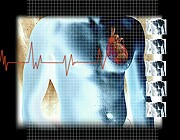
TUESDAY, May 3 (HealthDay News) — It costs $26 billion a year to treat U.S. patients with the heart rhythm disorder known as atrial fibrillation, according to a new study.
That total includes $6 billion for atrial fibrillation care, $9.9 billion for other cardiovascular risk factors or disease and $10.1 billion for non-cardiovascular medical problems, the researchers said.
“Atrial fibrillation places a huge economic burden on health care payers, patients and our country,” lead study author Dr. Michael H. Kim, an associate professor of medicine at Northwestern University in Chicago, said in a news release from the American Heart Association. “It is not clear that the country realizes that atrial fibrillation patients are much more likely to have cardiovascular hospitalizations specifically, and more hospitalizations in general.”
The study is published in the current issue of the journal Circulation: Cardiovascular Quality and Outcomes.
About 3 million American adults have atrial fibrillation, a number expected to double over the next 25 years, according to background information in the news release. Atrial fibrillation increases the risk of stroke and heart attack.
In the study, researchers analyzed 12 months of data collected from about 89,000 atrial fibrillation patients between 2004 and 2006. Of those patients, nearly 20 percent were newly diagnosed while 81 percent had existing atrial fibrillation.
Along with the $26 billion annual cost, the researchers also found that:
- Atrial fibrillation patients were hospitalized for any reason twice as often as people without atrial fibrillation (37.5 percent versus 17.5 percent) and were three times more likely to have multiple hospitalizations (11.1 percent versus 3.3 percent).
- Atrial fibrillation patients were hospitalized for cardiovascular problems four times more often than those without atrial fibrillation (21.3 percent versus 5.4 percent), and had multiple cardiovascular-related hospitalizations eight times more often (4.1 percent versus 0.5 percent).
- Atrial fibrillation patients were more likely than non-atrial fibrillation patients to die in the hospital (2.1 percent versus 0.1 percent).
- The average direct health care cost for an atrial fibrillation patient was $20,670, compared with $11,965 for a non-atrial fibrillation patient.
“We’re not going to impact health care costs or cardiovascular outcomes by just addressing atrial fibrillation itself,” Kim said. “The large amount of cardiovascular disease among atrial fibrillation patients appears to worsen outcomes and increase costs. This is a sicker population.”
More information
The American Academy of Family Physicians has more about atrial fibrillation.

